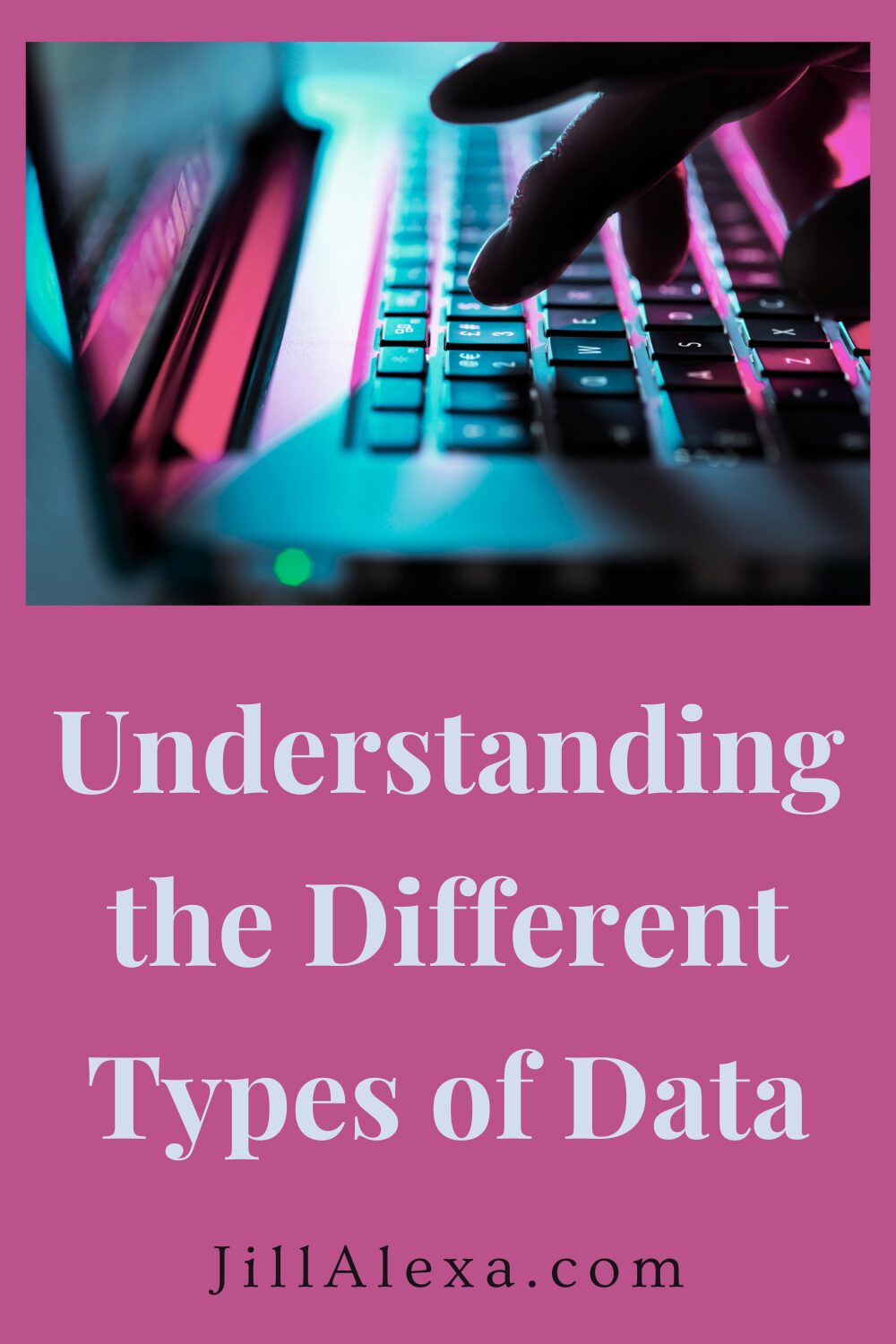Types of Data | JillAlexa.com
Each day, we generate vast quantities of data. From websites we visit to health apps that monitor our well-being, every digital interaction contributes to this ocean of data. Yet not all forms of information have the same properties and implications; different kinds of information exist.
Understanding the Different Types of Data
6 Types of Data to Understand, Interpret and Apply
1. Qualitative Data
Qualitative data provides a wealth of insight into its subject matter. Although non-numerical, qualitative data tends to be unstructured or semi-structured – making analysis challenging yet worthwhile in uncovering meaning and patterns buried deep beneath surface information.
Examples of qualitative data analysis are
- interviews
- focus groups
- observations
- textual analysis
- and more
Qualitative data is often used in sociology, anthropology and psychology. These are all fields that can fully grasp complex phenomena using quantitative methods alone.
Qualitative Data in Industries
Qualitative data has long been utilized across numerous industries for market research purposes, using it to gain an in-depth understanding of their target audience’s needs, behaviours and preferences.
Qualitative data provides invaluable help in shaping advertising strategies and developing new products or services.
Medical professionals utilize qualitative information to better understand patient experiences and enhance care quality; using insights gained from patient narratives for diagnosis and treatment purposes.
Education uses qualitative data to tailor teaching methods to different learning styles, while understanding students’ perspectives allows educational institutions to improve curricular design and delivery.
Qualitative data also plays a pivotal role in legal fields as it aids practitioners with context analysis of laws as well as analysis of themes with cultural significance in art forms such as sculpture and architecture.
2. Quantitative Data
Quantitative data differs from its qualitative counterpart in that it can be measured numerically and quantified, making it suitable for statistical analysis. Usually structured and collected using instruments with tangible results, quantitative data provides statistical insight and is best utilized as part of an effective research strategy.
Quantitative data can range from discrete amounts, like books read in a year, to continuous measures like room temperatures.
Quantitative information provides high levels of precision that allows us to make broad generalizations from small samples sizes.
Examples of quantitative data include:
- surveys
- experiments
- and secondary information
Its applications in finance involve analyzing market trends while healthcare uses quantitative data to track patient recovery rates and assess treatment effectiveness.
Quantitative data is indispensable in market research, helping measure consumer behaviour, calculate return on investment (ROI) and evaluate market penetration.
Education also relies on quantitative data as it allows them to examine student performance and teaching methods’ effectiveness.
While quantitative data provides valuable insight, its use alone may result in an incomplete picture or understanding of phenomena – something qualitative data fills.
 3. Primary Data
3. Primary Data
Primary data refers to information derived directly from first-hand experience.
This type of information is typically collected via original research projects designed and executed to answer specific research questions.
Methods for collecting primary data may include:
- observations
- interviews
- questionnaires
- and focus groups.
As these methods involve direct interactions with the subject of study, primary data collection offers greater authenticity and relevancy.
An economic market researcher may conduct surveys to learn consumer preferences for a new product.
An anthropologist might spend time living within a community to gain an in-depth knowledge of its culture.
Primary data is integral in areas like academia where original research forms the cornerstone of knowledge creation.
Unfortunately, collecting primary data can be time-consuming and costly but its depth and specificity of information can offer invaluable insights that may not otherwise exist.
4. Secondary Data
Secondary data refers to any information compiled by someone other than the user and often serves a different purpose than meets current needs; nonetheless, it may still offer valuable insights.
Secondary data sources include:
- government publications
- websites
- books
- journal articles
- and data collected by other organizations
An organization could utilize industry reports to gain a comprehensive view of market conditions, while social scientists could utilize census data for demographic analysis.
Secondary data collection tends to be cheaper and quicker than its primary counterpart, making it ideal for exploratory studies or when resources are limited.
Unfortunately, though, as it wasn’t collected specifically for your research project it might not always meet its requirements in terms of relevance and accuracy.
5. Big Data
In today’s age of digital transformation, big data has taken on an increasingly prominent role. As its name implies, “big data” refers to massive and complex datasets that traditional data-processing software cannot cope with.
Big data encompasses more than just its size: It also involves velocity and veracity of information gleaned from multiple sources such as social media posts, machine data logs and transactional records.
Big data’s power lies in its capacity to unlock insights that facilitate decision-making when properly analyzed. Industries including e-commerce, healthcare, finance and transportation are taking advantage of big data analytics to predict trends, enhance operations, provide superior customer experiences and gain competitive advantages.
But this data also poses unique challenges such as data privacy concerns, analytical complexity requirements and advanced skillset requirements; organizations must address these issues to maximize its benefits.
6. Glossary Data
Glossary data can be an overlooked source of valuable insight, particularly in complex or technical fields. It includes definitions of key terms, acronyms and concepts pertinent to an industry or organization’s topic of study or work environment.
Glossary data offers clarity and consistency by creating one universal language in terms of terminology and understanding.
In fields like healthcare, law, and IT where effective communication and operation are critical to success, glossaries play an essential role.
Glossary data can also be fed into machine learning algorithms or natural language processing systems to enhance their understanding and interpretation of complex, industry-specific jargon.
However, creating and maintaining an accurate glossary is a complex task which requires both an in-depth knowledge of the field as well as ongoing commitment for updates and revisions of it.
Glossary Data in Construction
Related: A Comprehensive Guide to Building Your Dream Home
The construction industry relies heavily on glossaries as an indispensable way of organizing its voluminous terminology, techniques, and laws.
As it contains its own set of unique jargon, techniques, and laws that need to be considered when making decisions it makes perfect sense that maintaining one is so crucial.
Words like “bidding”, “blueprint”, “load bearing” and “subcontractor” all have specific definitions in the construction context and their misuse can result in serious mistakes, delayed projects, legal complications or financial losses.
Glossary data serves an essential function in facilitating clear and precise communications among architects, contractors, engineers, clients and new employees alike.
Furthermore, glossaries help new hires quickly adapt to industry terminology.
Building and updating a construction glossary may provide many benefits, yet its creation and updating is no simple task; it requires deep industry knowledge and dedication to accuracy and consistency.
However, utilizing the construction glossary BuildOps can alleviate these challenges and provide contractors with up-to-date glossary data tailored to the unique needs of their projects.
Photo by Scott Graham on Unsplash
Conclusion – Types of Data
Understanding the various types of data allows us to use, interpret and make sense of the information at our disposal. While each type has its own strengths and weaknesses, combining multiple types can create a more holistic picture of any subject matter. Remember, data only becomes meaningful once we can leverage it for insight.
Which of these 6 types of data do you use in your line of work?

